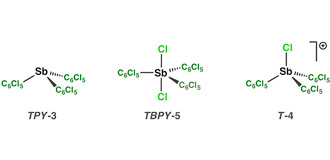|
The improved synthesis of the homoleptic perchlorophenyl stibine (C6Cl5)3Sb (1a) has enabled us to obtain detailed spectroscopic and structural information. In contrast to the planar structure shown by the nitrogen homologue (C6Cl5)3N, the antimony compound 1a shows unmistakable pyramidal structure (C-Sb-C 100.9(2)°, av.) with slightly elongated Sb-C bonds (219.6(4) pm, av.) with respect to the non-chlorinated model compound Ph3Sb. The Sb-C bonds shorten upon oxidation, as it is found in the oxidized compound (C6Cl5)3SbCl2 (2a). A single isomer is stereoselectively obtained for this hypervalent compound 2a, namely that with the Cl ligands in axial positions. This neutral, hypervalent compound (2a) is found to dissociate chloride in the gas phase (MS) giving rise to the [(C6Cl5)3SbCl]+ cation (3a). According to theoretical calculations this cation should have nearly tetrahedral structure and behave as a Lewis superacid. The structural properties and Lewis acidity of compounds 1a-3a are compared with those calculated for their corresponding isoelectronic tin derivatives (1b-3b).
|

